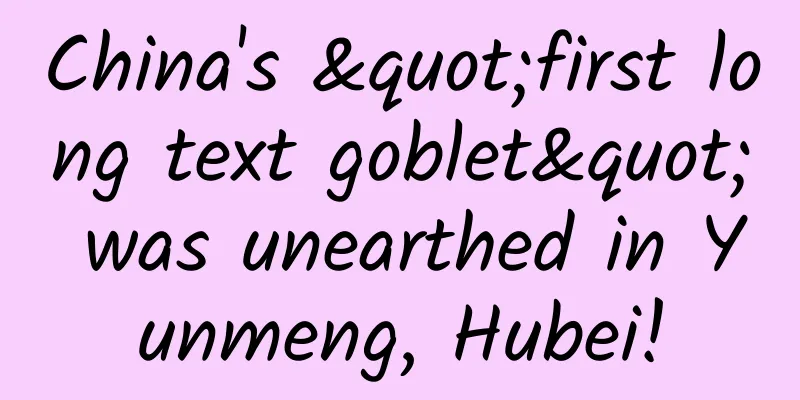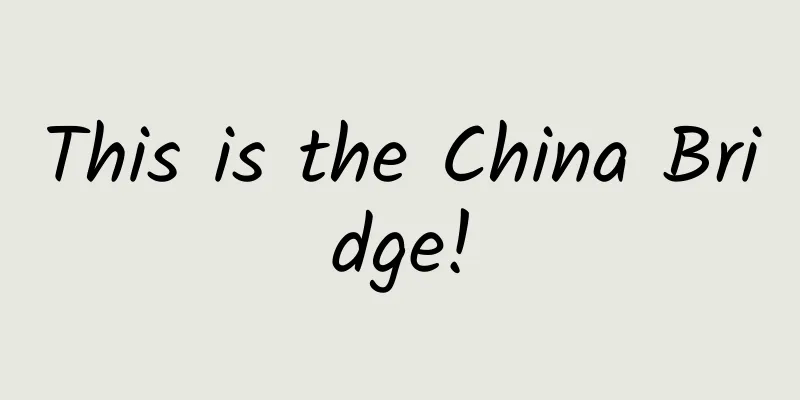China's "first long text goblet" was unearthed in Yunmeng, Hubei!

|
In September 2020, the Hubei Provincial Institute of Cultural Relics and Archaeology and the Yunmeng County Museum formed a joint team to conduct archaeological excavations at the Zhengjia Lake Cemetery in Chengguan Town, Yunmeng County, Hubei Province. Recently (November 16), the joint archaeological team of the Zhengjia Lake Cemetery in Yunmeng, Hubei Province disclosed that a heavyweight cultural relic was unearthed during the excavation: the earliest Chinese "longest text goblet" with more than 700 characters engraved on it. It is not the first time that Qin objects have been unearthed in Yunmeng. 46 years ago, the Shuihudi Qin Tomb, which shocked the world, was discovered here. The Yunmeng Qin Bamboo Slips found in the tomb at that time recorded in detail the development of Qin's politics, economy, culture, and medicine, and are still important materials for our research on the Qin Dynasty. The Yunmeng Qin Bamboo Slips from Shuihudi Why are there so many Qin tombs unearthed in Yunmeng? What kind of traces did the former empire leave here? Today, let's talk about the Shuihudi Tomb and the Yunmeng Qin Bamboo Slips. 01 Where is Yunmeng? The Zhengjia Lake Tomb discovered in 2020 and the Shuihudi Tomb discovered in 1975 are both located in Yunmeng County, Xiaogan City, Hubei Province today. Yunmeng County belonged to Xun State (a small state in the south near Chu that was granted fiefdom during the Western Zhou Dynasty) in the Spring and Autumn Period. During the Warring States Period, it was incorporated into the territory of Chu. During the Chu State's rule, Yunmeng area received special attention from the King of Chu because there was a huge group of lakes here, which was called "Yunmengze". Yunmengze Location Map The name of Yunmeng Lake was once very popular. This is the place that Meng Haoran refers to in his poem, "The air is steaming over Yunmeng Lake, and the waves are shaking Yueyang City." It is also described as a dreamlike place in Sima Xiangru's "Zixu Fu": "Yunmeng is nine hundred miles square." There are mountains that are so high that they reach the blue sky and block the sun and the moon. There are not only soil and stones of various colors, but also metals and beautiful jade. There are many kinds of fragrant herbs growing on the hillsides and watersides in the east, while in the south there are "plains and wide lakes," and in the west there are "springs and clear pools," and there are "divine turtles, dragons, tortoises, and turtles." It was probably because of the seclusion of Yunmeng Lake surrounded by mountains and waters that this mysterious and misty lake was the exclusive hunting area of the King of Chu for a long time. The king's favor brought about the rise of status, and Yunmeng became the secondary capital of Chu. However, there are still some disputes among scholars about the relationship between Yunmeng and Yunmeng Lake. The official establishment of Yunmeng County was in the 16th year of Datong in the Western Wei Dynasty (550 AD). From the Qin Dynasty to the Wei and Jin Dynasties, Yunmeng was under the jurisdiction of Anlu County. Therefore, some scholars believe that the name Yunmeng should be derived from Yunmeng Lake. However, some scholars hold different opinions - the name Yunmeng had already appeared in ancient books as early as the pre-Qin period. In addition, the area where Yunmeng County is located today is different from the Yunmeng area in the pre-Qin period in terms of specific geographical divisions. The Yunmeng Lake has been shrinking since the Qin Dynasty, and the Yunmeng area in the pre-Qin period should be much larger than the scope of Yunmeng County today. Therefore, there are different opinions on whether Yunmeng County was named after Yunmeng Lake or Yunmeng Lake was named after Yunmeng County. However, it is certain that as early as the Pre-Qin period, there was a vast group of lakes in the area of Yunmeng County today, and the prominence of Yunmeng area during the Chu-Qin period was also closely related to this lake. During the Qin Dynasty, Yunmeng Lake was gradually reduced due to the continuous sedimentation of the Yangtze River and Han River and the impact of human activities. During the Wei, Jin, Southern and Northern Dynasties, it had shrunk to half of its original size. During the Tang and Song Dynasties, it disintegrated into a group of small lakes scattered across the lake. Yunmeng was connected with Qin State in the late Warring States Period. In 453 BC, Han, Zhao and Wei eliminated Zhi clan and divided Jin, which laid the foundation for the seven powers of the Warring States Period. Later, Qin gradually became the only one. After eliminating Han in 230 BC, Qin began to unify the six kingdoms. In 224 BC, the King of Qin invited the veteran general Wang Jian to lead an army of 600,000 to attack Chu. During the war for Qin to unify Jing and Chu, Yunmeng once served as a fortress to protect the city - these vast lakes blocked the Qin's attack, causing the battle to be stalemate for a time. In 278 BC, Qin general Bai Qi captured the capital of Chu, Ying. After that, Yunmeng became the base of the Qin army. In the process of Qin's unification of the southern countries, Yunmeng was an extremely important strategic location. After Qin unified the six kingdoms, Qin Shihuang also visited Yunmeng twice and set up a highway, a temporary palace and a royal forbidden garden here. Map of the Six Kingdoms in the Early Warring States Period In general, Yunmeng has close ties with both Chu and Qin: from a geographical point of view, it was once a strategic fortress for Chu to fight against Qin; from a temporal point of view, it witnessed important historical scenes in the process of unification of the Qin Empire. Probably because of this, a large number of Qin and Han Dynasty tombs have been excavated in Yunmeng since 1972, forming a vast ancient tomb group in the southeastern and western suburbs of Chengguan Town, Yunmeng County. This ancient tomb group consists of five small tomb groups: Zhenzhupo Tomb Group, Longgang Tomb Group, Carpenter Tomb Group, Shuihudi Tomb Group, and Dafentou Tomb Group. Its time span is from the Eastern Zhou Dynasty to the end of the Han Dynasty, with the largest number of ancient tombs from the Qin Dynasty. Among these ancient tombs of various sizes, the most widely known is the Shuihudi Qin Tombs excavated in 1975. 02 The surprising discovery of the Qin Dynasty tomb at Shuihudi The discovery of the Shuihudi Qin Tombs was by chance. In the winter of 1975, at dusk, a farmer on his way home found the soil of a newly dug drainage ditch very strange. The farmer had experience in excavating ancient tombs, so he immediately reported it to the relevant authorities. As a result, more than 50 Qin tombs were discovered. Shuihudi Qin Tomb Excavation Site Plan of the interior of the M11 coffin Among these Qin tombs, the owner of Tomb M11 was the Qin Dynasty official "Xi". It was in his tomb that the staff discovered the "Shuihudi Qin Tomb Bamboo Slips", also known as the Yunmeng Qin Slips. Yunmeng Qin Bamboo Slips, source: Hubei Provincial Museum official website Xi was born in the 45th year of King Zhao of Qin (262 BC). In the first year of King Zheng of Qin, Xi, who was only 17 years old, was registered to serve as a corvée in Qin. After that, he served as a low-level official in many criminal law matters. In addition, he joined the army three times in the third, fourth and thirteenth years of King Zheng of Qin, participated in many battles, visited several counties in Qin, and finally died in office. Xi personally experienced the entire process of Qin Shi Huang's unification of the six kingdoms. The document "Chronicles", which records Xi's life, also confirms the most glorious era of Qin. In addition to the Yunmeng Qin Bamboo Slips, two of China's "earliest family letters" were unearthed in the Qin Tomb of Shuihudi. The writers were named "Heifu" and "Jing", the two younger brothers of the tomb owner "Zhong". Heifu and Jing were both conscripted to join the army, leaving their brother Zhong at home to take care of their mother. The main content of these two letters was to ask if the family was well. Image source: Hubei Provincial Museum official website It is also related to Xi's occupation during his lifetime. He copied a large number of legal documents on bamboo slips. Thanks to these bamboo slips he left behind during his lifetime, we are able to rediscover a corner of the huge Qin Empire society. 03 Yunmeng Qin Bamboo Slips, Restore the True Laws of the Qin Dynasty The total number of Qin bamboo slips excavated from Tomb M11 is about 36,000, covering the period from the 25th year of King Zheng of Qin to the first year of the Second Emperor of Qin. Influenced by the identity of the tomb owner "Xi", most of these bamboo slips are archival documents of the Qin local government, including government decrees, official documents between governments at all levels, judicial documents, clerk books, material registrations, as well as transfer and mileage books. Among them, the most important content is various Qin legal documents, totaling more than 600. There are 53 "Chronicles" recording Xi's life, 14 "Nanjun Documents", 50 "The Way of Being an Official" and other miscellaneous manuscripts, as well as "Daily Books" and other books of divination. Most of these Qin bamboo slips are well preserved. The texts on the bamboo slips are written in ink in the Qin official script, with clear and elegant handwriting and thick and simple strokes. Some bamboo slips have text written in ink on both sides, but most of them are only written on the bamboo strips. The bamboo slips are tied together with thin ropes in three parts: upper, middle and lower, and compiled into volumes in order. In general, the content covered by this batch of Qin bamboo slips is extremely extensive. The contents in the bamboo slips involve the Qin Dynasty's legal system, administrative documents, medical knowledge, animal husbandry, and divination knowledge of auspicious and inauspicious days, providing us with extremely rich first-hand information on Qin Dynasty society. The ink-written Qin Li script used to write the Qin bamboo slips also reflects the situation of the transition from seal script to official script, providing a good physical example for the study of Chinese calligraphy. Close-up of the Yunmeng Qin Bamboo Slips In particular, the description of Qin Law in the Yunmeng Qin Bamboo Slips is not only extremely detailed, but also more credible than historical records. This information provides important reference value for us to understand the Qin Dynasty political system, and also provides us with a new perspective to understand Qin Law. For example, according to the description of Qin Law in Han Dynasty historical books, we usually have the impression that Qin Law is extremely strict. But in fact, the perfection of Qin Law and the meticulous management are extremely surprising. It is recorded in the Daily Book: "If a small animal enters a person's house, the person in the house throws it to him, and kills it with a sword, the value of which is 250 coins, which is equivalent to a yellow armor." This clearly states the protection of the six domestic animals (horses, cattle, sheep, pigs, dogs, and chickens), and killing small animals requires compensation. The Qin laws also had clear provisions on the breeding, grazing, management, and use of official cattle and horses, as well as the rewards and punishments for managers (see "Stable and Garden Laws", "Canglu Laws", "Sikong", "Xiaolu", and "Miscellaneous Qin Laws"). Basically, the Qin laws took into account almost every possible dispute and problem that might arise in the process of raising livestock. Of course, the harshness of Qin law was not groundless. Originally in the slave society, a person who committed a crime was punished by "exterminating three clans", but in Qin law, this was extended to the point of exterminating seven clans, or even ten clans. In addition, based on the records of the Yunmeng Qin Bamboo Slips, we can also re-judge some important events in history. Among them, the more controversial content is the "Chen Sheng and Wu Guang Uprising". According to the "Historical Records", the source of the Chen Sheng and Wu Guang uprising was the abuse of the common people by the Qin tyranny - the original text of the "Historical Records" reads: It rained heavily, the roads were blocked, and we missed the deadline. According to the law, if we miss the deadline, we will all be beheaded. Chen Sheng and Wu Guang then conspired and said, "If we die now, we will die. If we make a big plan, we will die too. Is it okay to wait and die for the country?" Chen Sheng and Wu Guang Uprising In other words, Chen Sheng and Wu Guang were only delayed by a heavy rain, but the Qin law wanted to behead them. It was under this pressure that Chen Sheng and Wu Guang led the first peasant uprising in Chinese history. However, in the Yunmeng Qin Bamboo Slips, the record of "missing the deadline" is as follows: "The imperial court issued a levy, but was unable to go, and was fined two armors. If the deadline is missed by three to five days, it will be punished; if it is missed by six to ten days, it will be fined one shield; if it is missed by ten days, it will be fined one armor. If it rains, the expedition will be cancelled." It is clearly written here that if someone fails to go when summoned by the imperial court, the maximum penalty is to pay the money for two sets of armor. If the person fails to go on time due to weather reasons such as rain, he can be exempted from punishment. In other words, "missing the deadline" does not constitute a serious crime, and Chen Sheng and Wu Guang did not have to worry about their lives. In this case, how much did the cause of Chen Sheng and Wu Guang's uprising have to do with Qin's tyranny? Why did they revolt? These reasons need to be reconsidered. 04 Zhengjiahu Cemetery Following the Qin Tomb at Shuihudi, other Qin and Han tombs have been excavated in Yunmeng area. Most of the unearthed artifacts were made of copper, iron, pottery, lacquer wood, silk, jade, and bamboo. The original excavation sites were also concentrated near the outskirts of Yunmeng city. The Zhengjiahu cemetery, which began to be excavated in 2020, is located in the southeast suburb of the Chuwangcheng site, about 3,000 meters away from the Shuihudi cemetery. According to the needs of the construction project, the entire tomb complex was divided into three parts: A, B, and C. M276 Head Box Objects There are 196 tombs in areas A and B, all of which were excavated in 2020. These are all small tombs after Qin captured Ying in the late Warring States Period, and should be the civilian tombs of the Chu people and their survivors. There are more than 700 pieces/sets of cultural relics unearthed in Areas A and B, most of which are pottery, mainly tripods, cauldrons, pots, boxes, plates, basins, li, yu, dou, double-eared jars, etc. In addition, some bronze, jade and lacquered wood wares were also unearthed. Flat pot Tiger Head Pillow The C-Zone Tomb Group was excavated in 2021. There are 108 ancient tombs in total, including 9 well-preserved water-filled tombs. More than 850 pieces/sets of cultural relics were unearthed from the C-Zone Tomb Group, mainly lacquered wooden objects, with more than 400 pieces. Other unearthed cultural relics include pottery, bronze, jade, lacquerware, bamboo and silk fabrics. In addition, in the tombs in Area C, there are paintings on the door panels of three tombs and on the lintel of one tomb, dating from the end of the Warring States Period to the Qin Dynasty and the Qin and Han Dynasties, and the themes of the paintings are all new. These paintings fill the historical gap in the materials and types of Qin and Han paintings, and provide important materials for studying the burial customs, rituals, religious thoughts, and artistic modeling of the Qin people. The most important artifact unearthed in this excavation is the "first long-text goblet". The wooden goblet was one of the writing media of the Chinese before the invention of paper, and the content engraved on this wooden goblet mainly records the story of the counselor Shu persuading the King of Qin to stop fighting and establish justice. The story takes place in the late Warring States period, when the Qin State was strong. The five eastern states formed an alliance to resist the Qin State and achieved a temporary victory. They sought a truce with the Qin State, so they sent a counselor, Shu, to the Qin State to lobby the King of Qin. Then, the counselor, Shu, quoted classics and what he had seen and heard, and persuaded the King of Qin to stop the war and let the people live and work in peace. The full picture of "The First Long Wen Gu", source: Hubei Provincial Cultural Relics Bureau The entire guwen is rich in content, not only involving many fields such as archaeology, ancient philology, ancient literature, ancient history, etc., but also provides us with a picture of the struggle and mediation between the Eastern countries and Qin in the late Warring States period, and details the relationship between Wei, Yue, and Wu during the Spring and Autumn Period and the Warring States Period. In addition, the "Battle of Wei and Yue in Suxu Field" mentioned in the guwen is the first time, providing us with new materials for exploring the historical facts of the Spring and Autumn Period and the Warring States Period. The Yunmeng Warring States Tomb No. 274, where a long wooden goblet with inscriptions was unearthed. Image source: Hubei Provincial Institute of Cultural Relics and Archaeology According to the research of scholars who participated in the excavation, judging from the tomb shape and the scale and quality of the funerary objects, the owner of Tomb No. 274, who unearthed the "first long inscribed gu", should have a lower status than the owner of the Qin bamboo slips tomb at Shuihudi. The tomb owner lived in an era when the Qin army continued to conquer the eastern countries. Because of the huge cost of the war, he had a strong war-weariness. It was probably because of this that he recorded the story of the counselors persuading the King of Qin to stop the war on a wooden goblet and placed it in the tomb to rest here with himself. References: "A Clarification of the Yunmeng Qin Bamboo Slips" by Huang Shengzhang Liye Qin Bamboo Slips and the Qin Local Official System Huang Hailie "On the Livestock Farming Industry of Qin State from the Yunmeng Qin Bamboo Slips" by He Runkun Yunmeng and Yunmeng Lake by Tan Qixiang -END- Recruitment, Contribution, Cooperation Reply to keywords in the background to get them immediately Editor: Fried Egg The picture comes from the Internet. If there is any infringement, please contact us to delete it. Source | Art Travel Culture |
<<: Why is it so bitter when you take a bite of cucumber? That's the cucumber crying for help!
>>: Everyone talks about global warming, so why is this winter still so cold?
Recommend
How much does it cost to develop an audio and video mini program in Zunyi?
How much does it cost to develop the Zunyi Audio ...
Severe cases can be fatal! These 4 things may cause blood clots, which many people often do but have been ignored
In life, many people may not regard thrombosis as...
Tianlai Karaoke Co-founder Hao Jie: Big screen life connects happiness
On the afternoon of October 14, a sub-forum entit...
How about Estee Lauder skincare products? Are Estee Lauder skincare products good?
Estee Lauder is a brand loved by many women! It i...
Second-class e-commerce advertising | 15 product cases in 7 categories!
The hot August gathers the enthusiasm of midsumme...
How to write copy that highlights user pain points? Use these 4 routines!
Users don't choose the best option, but rathe...
It is reported that Great Wall plans to establish a new independent brand of new energy vehicles, focusing on SUVs and sedans
Recently, foreign media revealed that Great Wall ...
iOS 18 update push, several changes!
This morning, Apple pushed out iOS 18 Beta 4, ver...
Douyin 0 fans direct play movie gameplay + movie anti-shielding technology (full set of information) for sale outside 588 yuan
Douyin 0 fans direct play movie gameplay + movie ...
Interpreting the legend of the Silk Road! The ingenious Shu brocade was woven by this super "programming machine"
Among Chinese silk artworks, brocade is one of th...
SIA: Global semiconductor sales fell to US$39.7 billion in February 2023, down 20.7% year-on-year
Recently, according to foreign media reports, aff...
Let Chinese e-sports see hope, but the master said that playing professionally is more difficult than getting into Tsinghua University or Peking University
Recently, e-sports fans have received exciting go...
How to produce high-quality product copy?
1. Purpose of writing First of all, we need to un...
Baidu Q3 financial report: "A practitioner of a strong transportation nation" Apollo intelligent transportation business has been launched in many cities
On November 7, Beijing time (November 6, Eastern ...
It is said that this is the evil-repelling beast that feeds on copper and iron!
Has everyone watched the drama "Border Water...









